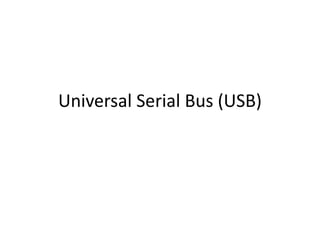
Chapter-6_2.ppt
- 1. Universal Serial Bus (USB)
- 2. Universal Serial Bus • A representative peripheral interface • Universal Serial Bus (USB) provides a serial bus standard for connecting devices, usually to a computer, but it also is in use on other devices such as set-top boxes, game consoles and PDAs. (wikipedia.org)
- 3. What USB Can Do • USB is a likely solution any time you want to use a computer to communicate with devices outside the computer. • The interface is suitable for one-of-kind and small-scale designs as well as mass- produced, standard peripheral types.
- 4. USB • Fast • Bi-directional • Isochronous • low-cost • dynamically attachable serial interface • consistent with the requirements of the PC platform of today and tomorrow
- 5. USB • Four wires (+5V, Return, data twisted pair) • Up to 5 m (16.4 ft) Longer connections use hubs or active extensions
- 6. Features of USB • Easy to use for end user – Single model for cabling and connectors – Electrical details isolated from end user (e.g., bus terminations) – Self-identifying peripherals, automatic mapping of function to driver, and configuration – Dynamically attachable and re-configurable peripherals • Wide range of workloads and applications – Suitable for device bandwidths ranging from a few kb/s to several Mb/s – Supports isochronous as well as asynchronous transfer types over the same set of wires – Supports concurrent operation of many devices (multiple connections) – Supports transfer of multiple data and message streams between the host and devices • Low-cost implementation – Low-cost sub-channel at 1.5Mb/s – Suitable for development of low-cost peripherals – Low-cost cables and connectors • Upgrade path – Architecture upgradeable to support multiple USB Host Controllers in a system
- 7. Features of USB (cnt..) • Isochronous bandwidth – Guaranteed bandwidth and low latencies appropriate for telephony, audio, etc. – Isochronous workload may use entire bus bandwidth • Flexibility – Supports a wide range of packet sizes, which allows a range of device buffering options – Allows a wide range of device data rates by accommodating packet buffer size and latencies – Flow control for buffer handling is built into the protocol • Robustness – Error handling/fault recovery mechanism is built into the protocol – Dynamic insertion and removal of devices is identified in user-perceived real-time – Supports identification of faulty devices
- 8. Comparison Interface Format Number of Devices (maximum) Length (maximum, feet) Speed (maximum, bits/sec.) Typical Use USB asynchronous serial 127 16 (or up to 96 ft. with 5 hubs) 1.5M, 12M, 480M Mouse, keyboard, disk drive, modem, audio RS-232 (EIA/TIA-232) asynchronous serial 2 50-100 20k (115k with some hardware) Modem, mouse, instrumentation Parallel Printer Port parallel 2 (8 with daisy-chain support) 10–30 8M Printers, scanners, disk drives
- 9. Benefits for Users • Ease of Use Ease of use was a major design goal for USB, and the result is an interface that’s a pleasure to use for many reasons: • One interface for many devices. USB is versatile enough to be usable with many kinds of peripherals. Instead of having a different connector type and supporting hardware for each peripheral, one interface serves many. • Automatic configuration. When a user connects a USB peripheral to a computer, its OS automatically detects the peripheral and loads the appropriate software driver. • Hot pluggable We can connect and disconnect a peripheral whenever you want, whether or not the system and peripheral are powered, without damaging the PC or peripheral. The operating system detects when a device is attached and readies it for use. • No power supply required (sometimes). A peripheral that requires up to 500 milliamperes can draw all of its power from the bus instead of having its own supply..
- 10. USB USB 1.0 specification introduced in 1994 USB 2.0 specification finalized in 2001 Became popular due to cost/benefit advantage Eg. IEEE 1394 – high bandwidth, high cost Three generations of USB USB 1.0 USB 2.0 USB 3.0 and WUSB
- 11. Physical Appearances • Type A connectors on host devices that supply power • Type B connectors on target devices that receive power.